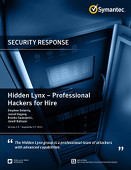Malicious software is nothing new. Computer viruses and worms have been around for decades, as have most other families of malware like remote access tools (RATs) and key loggers. But all our experience with malware hasn’t made the job of knowing when our organization has been hit by it any easier. In fact, recent news stories about breaches at Home Depot, Target, Staples and other organizations makes it clear that even sophisticated and wealthy corporations can easily overlook both the initial compromise and endemic malware infections – and at great cost. That may be why phrases like “dwell time” or “time to discovery” seem to pop up again and again in discussions of breach response. There’s no longer any shame in getting “popped.” The shame is in not knowing that it happened. Greg Hoglund says he has a fix for that latter problem. His new company, Outlier Security, isn’t “next generation […]
Bit9
APT-For-Hire: Symantec Outs Hidden Lynx Hacking Crew
This site and others have been writing about the “Advanced Persistent Threat” problem, which has generally been treated as a euphemism for the government and military of The People’s Republic of China or – in some cases – Russia, Iran, North Korea or other un-friendlies. Firms like Mandiant have taken pains to separate the concept of APT from run of the mill cyber criminal hacking groups whose motivation is profit, rather than the acquisition of information that can be used to advance geopolitical or economic goals. Cyber criminal groups may well use “advanced” in their attack methods and “persistent” in their efforts to compromise victim networks, but they weren’t “APT.” Now Symantec Corp. has put a fly into that ointment: publishing a report that pulls the covers off an APT group dubbed “Hidden Lynx” that it claims is responsible for some of the most sophisticated and large scale hacks of […]
Bit9: 32 Pieces of Malware Whitelisted In Targeted Hack
The security firm Bit9 released a more detailed analysis of the hack of its corporate network was part of a larger operation that was aimed a firms in a “very narrow market space” and intended to gather information from the firms. The analysis, posted on Monday on Bit9’s blog is the most detailed to date of a hack that was first reported on February 8 by the blog Krebsonsecurity.com, but that began in July, 2012. In the analysis, by Bit9 Chief Technology Officer Harry Sverdlove said 32 separate malware files and malicious scripts were whitelisted in the hack. Bit9 declined to name the three customers affected by the breach, or the industry segment that was targeted, but denied that it was a government agency or a provider of critical infrastructure such as energy, utilities or banking. The broad outlines of the story about the hack of Bit9, which sells […]
Bit9 Defends Response To Hack, Promises More Details
The security firm Bit9 defended its response to a hack of its own network last week and promised to release more information to the public about what happened – just not quite yet. In a blog post dated Saturday, February 9, the company’s CTO, Harry Sverdlove, said that the company responded promptly to the attack and contacted customers as soon as it completed its own investigation of the hack, which allowed unknown assailants to sign malicious programs using a Bit9 code signing server. That malware was subsequently released on networks of Bit9 customers. Sverdlove said the company’s “first and foremost priority was to inform our customers quickly and directly,” and that the company did so “as soon as we understood and had mitigated the attack, and we were able to provide actionable advice.” The blog post by Sverdlove, just a day after a post by Bit9 CEO Patrick Morley that disclosed […]
Whitelist Goes Black: Security Firm Bit9 Hacked
Application “whitelisting” offers an alternative to signature based malware protection. Rather than trying to spot the bad guys, the thinking goes, just identify a list of approved (whitelisted) applications, then block everything else. But what happens when the whitelist, itself, becomes compromised? That’s the scenario that’s playing out with customers of whitelisting firm Bit9, which acknowledged a breach of its corporate network that allowed unknown assailants to gain control of an application code signing server. The acknowledgement came after Bit9 was contacted regarding the breach by Brian Krebs of Krebsonsecurity.com, which broke the news Friday. Little is known about the incident. In a blog post, Bit9’s CEO, Patrick Morley, said that only three of the company’ s customers were affected. Those customers identified malware on their networks that had been signed by one of Bit9’s code signing servers. The lapse was the result of a breach on Bit9’s own network. […]


